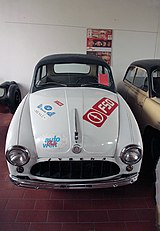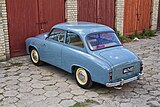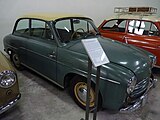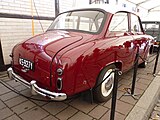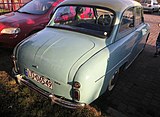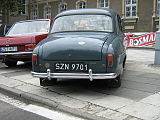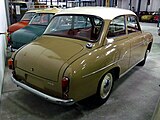Syrena
Syrena was a Polish car brand. The name Syrena (Polish for mermaid ) can be traced back to the Warsaw mermaid in the Warsaw city arms.
Brand history
Fabryka Samochodów Osobowych , FSO for short, from Warsaw developed the cars and presented the first vehicles at the 1955 industrial exhibition in the buildings of the Poznań International Fair in Poznan . Series production at FSO ran from 1957 to 1972. Subsequently, the company Fabryka Samochodów Małolitrażowych , FSM for short, from Bielsko-Biała took over production. Production ended on June 30, 1983. Originally, the vehicles were only planned as an intermediate type.
vehicles
Air inlet with 8 vertical struts, above in capital letters SYRENA on the front panel, above the bonnet
Decorative strip, if present, below the door handle with a downward curve behind the door, then further horizontally
Decorative strip, if present, at the level of the door handle with a small downward curve behind the door, then falling further
General
A box frame formed the basis of the vehicles. A two-door body was mounted on it. It was a sedan with notchback . The two-stroke engine with water cooling was installed front of the vehicle and drove to the front wheels. The four-speed gearbox was operated via a selector lever on the steering wheel . The wheelbase was 230 cm.
Prototypes
The prototypes from 1955 onwards had an air inlet with eight vertical struts. Above it were the capital letters SYRENA on the front panel. Above it was the bonnet . The two-cylinder in - line engine had a 76 mm bore and 82 mm stroke . This resulted in a displacement of 744 cc and an output of 27 hp . The tank was located in the front of the vehicle. The doors were hung on the B-pillar . The windshield wipers did not run in the same direction, which was changed later.
100
The series version appeared in 1957. The air inlet had three horizontal chrome struts, the upper one of which was rounded on the sides and went down to the bottom. Immediately above it came the bonnet with the FSO logo emblazoned on it. For March 1960 it is stated that the third and fourth gears of the transmission were synchronized , although it remains unclear how it was before. The track width was at least 120 cm from 1960 onwards. At the time it is 408 cm long, 155 cm wide and 152 cm high. Values of 880 kg and 874 kg have been handed down as empty weights. At the stern there was a round and a rectangular rear light, both in red. The trunk lid reached to the rear bumper .
According to one source, 4,895 vehicles were built between 1957 and 1960.
101
The 101 followed in 1960. The data did not change. Many vehicles now had a side trim strip on each side of the vehicle, although it remains unclear whether it was standard. It ran below the door handle, made a downward swing behind the door, and then continued horizontally. The round tail light was now yellow, so it was obviously the indicator . In most cases the trunk lid was shortened and no longer reached the bumper. In between there was space for the license plate . For March 1962 30 HP and 870 kg curb weight are given in a source.
According to one source, 8,347 vehicles were built between 1960 and 1962.
102
The 102 followed in 1962. The rear track was now 124 cm. The height is only 145 cm and the empty weight is 900 kg. According to a source, the engine made 27 hp again. At the rear there were now one-piece taillights that were yellow in the upper area and red in the lower area. On photos are reflectors can be seen in various photos.
There was also a variant called the 102 S. It had a three-cylinder in-line engine from the Wartburg 311 . It had 73.5 mm bore, 78 mm stroke, 993 cm³ displacement and 45 hp. The grille and molding were distinguishing features.
According to one source, 11,141 vehicles were built between 1962 and 1963 and 141 of the 102 S only in 1963.
103
The 103 followed in 1963. There was now a radiator grille with 15 vertical and 10 horizontal struts at the front. The engine developed 30 hp. The specified vehicle height is 151 cm. Between the rear window and the trunk lid was the fuel filler neck on the right side .
At the same time there was the 103 S. It had the already mentioned Wartburg engine, which was specified here with 40 hp. The gearbox with synchronization in gears two to four also came from the Wartburg. The curb weight is given as 950 kg. An illustration shows a wider decorative strip.
According to one source, 29,767 vehicles were built between 1963 and 1966 and 391 of the 103 S were only built in 1964.
104
The 104 appeared in 1966. It had a different three-cylinder engine. A 70 mm bore and 73 mm stroke resulted in a displacement of 843 cc and 40 hp. The four-speed gearbox was fully synchronized. The front indicators were much larger than before. The side trim was at the level of the door handle. It only made a slight swing down behind the door and then dropped slightly to the back. But there are also photos of vehicles without a trim. This model is specified as being 404 cm long, 156 cm wide and 151.5 cm high. The curb weight was 910 kg.
According to one source, 113,689 vehicles were built between 1964 and 1972, with series production only starting in 1966.
105
The 105 followed in 1972. The doors were hinged on the A-pillar . The door handle was mounted higher than its predecessor and was therefore above the decorative strip. The first vehicles were built at FSO, so they had the FSO emblem on the bonnet. After FSM took over the assembly in the same year, the FSM logo was placed on the bonnet.
According to a source, 3571 vehicles were built at FSO in 1972.
Special bodies with series production
Bosmal built a pickup truck based on the 105 . The car was named 105 B or 105 Bosto. The spare wheel was mounted on the roof of the driver's cab. The cargo hold had side windows in the front area. The vehicle was also available with rear seats. There are pictures of vehicles with this structure, but doors hinged on the B-pillar. One source names these vehicles 104 B.
The pick-up based on the 105 was called the R-20.
More prototypes
A special feature was a coupé . It was presented at a motor show in Brussels . A two-seat plastic body was mounted on a platform frame. The wheelbase of 230 cm and the front track of 120 cm corresponded to the sedan. The rear track was 124 cm. The curb weight was given as 710 kg. The engine was different. It was a two-cylinder boxer engine with overhead valves that worked in four-stroke cycles. The displacement of 744 cm³ corresponded to the sedan's engine, although the bore and stroke are not known. The engine performance is also not recorded. One source gives the year 1960. The Automobil Revue listed the vehicle between 1961 and 1962 in their catalogs.
In addition, a minivan was designed in the style of the Lloyd LT . Photos of vehicles with two different Polish license plates are known .
The 110 from around 1966 was a station wagon with a large tailgate . One source indicates a four cylinder four stroke engine . Of these, there are still at least two vehicles that differ in terms of the front design, the side position lights and the exterior mirrors .
There are also photos of a 607 with a hatchback and tailgate. The sideline is similar to the 1004 glass as CL. The front with the large indicators corresponds to the 104 and 105. The doors are hinged at the front. There are references to the years 1970 and 1971.
Quantities
According to one source, 177,234 vehicles were produced at FSO by 1972. 344,077 vehicles are named for the time at FSM. In total, that's 521,311.
Another source gives the number per model for assembly at FSO and comes to a total of 171,942.
Brand name or just model name?
There are different views in the literature as to whether Syrena was really the brand name. There is also the variant that the brand name was changed from Syrena to FSM in 1972.
Until 1972
Many sources state that the vehicles were marketed as Syrena until at least 1972. This includes the catalogs of the Swiss Automobile Review. In the German car catalogs from model year 1958 to 1967 only the Syrena brand is mentioned.
One source suggests that Syrena was just a model name. According to this thesis, the manufacturer abbreviation was placed in front and the vehicles were offered as FSO Syrena.
There are also mixed forms. Harald H. Linz and Halwart Schrader have an entry on the Syrena brand in their newer encyclopedia , in which they write several times about Syrena and once about FSO Syrena, which ends in 1972.
The car catalog for the model year 1968 writes FSO Syrena 104, but also FSO Warszawa, although Warszawa was the brand name of the car, which was also built by FSO, so that it is clear that all models of the manufacturer FSO are grouped together here, regardless of their brand.
For the model years from 1969 to 1972, the German car catalogs have a collective entry for the manufacturer FSO, which contains the Syrena 104, the Polski Fiat 125p and the Warszawa.
It is clear that the first prototypes had the SYRENA logo on the front of the vehicle. In the standard versions, the round FSO emblem was on the bonnet. A lettering for the exact model (100 to 105) was often attached to the rear.
From 1972
Some sources state that the vehicles were marketed as Syrena even after 1972.
Other sources suggest that Syrena was just a model name. According to this thesis, the manufacturer's abbreviation was placed in front and the vehicles were offered as FSM Syrena.
For the model years from 1973 to 1974, the German car catalogs have a collective entry for the manufacturer FSO, which contains the Syrena 104, the Polski Fiat 125p and the Warszawa. However, this information is incorrect because FSO was no longer the manufacturer at the time.
For the 1978 model year, the German car catalog has the text under the Syrena brand and the technical data in the FSM section.
It is clear that from 1972 the FSM emblem was on the bonnet. A lettering for the model 105 was often attached to the rear.
Tried reprint
In 2014, the AMZ-Kutno company presented the prototype of a retro model in Kutno , which was developed as the “Syrena of the 21st century” and was intended as a “modern equivalent”.
literature
- Development prospects of the Polish automotive industry. In: Motor vehicle technology , issue 2/1956, pp. 42–43.
Web links
- GTÜ Society for Technical Monitoring ( Memento from December 6, 2015 in the Internet Archive )
- Jêdrzej Lubicz: Internet site about the history of Syrena (English)
- Syrena Sport, najpiękniejszy polski samochód ( Memento from September 18, 2012 in the Internet Archive ) - article at eioba.pl (Polish, last archive page from September 18, 2012 at archive.org)
Individual evidence
- ↑ a b c d George Nicholas Georgano (Ed.): The Beaulieu Encyclopedia of the Automobile . Volume 1: A-F . Fitzroy Dearborn Publishers, Chicago 2001, ISBN 1-57958-293-1 , pp. 596 (English).
- ↑ From Polish vehicle construction. In: Motor vehicle technology , edition 2/1958, p. 63.
- ↑ a b c d e f g Production figures (Polish) ( Memento from September 23, 2007 in the Internet Archive )
- ↑ Classic Car Catalog 1963 (Polish, accessed April 25, 2020)
- ↑ Classic Car Catalog 1964 (Polish, accessed April 25, 2020)
- ↑ Classic Car Catalog 1965 (Polish, accessed April 25, 2020)
- ↑ Classic Car Catalog 1966 (Polish, accessed April 25, 2020)
- ↑ Photo of a 103 S (accessed April 25, 2020)
- ↑ Story of Bosmal (accessed April 25, 2020)
- ↑ Classic Car Catalog 1972 (Polish, accessed April 25, 2020)
- ↑ a b Harald H. Linz, Halwart Schrader : The International Automobile Encyclopedia . United Soft Media Verlag, Munich 2008, ISBN 978-3-8032-9876-8 , chapter Syrena.
- ↑ W 303 PR and W 603 PR (accessed April 25, 2020)
- ^ A b c Manfred Dünnebier, Eberhard Kittler : Passenger cars of socialist countries. Transpress-Verlag for Transport, Berlin 1990, ISBN 3-344-00382-8 , pp. 86-109.
- ↑ Photo of a vehicle with registration and photo of a museum vehicle without recognizable registration (accessed April 25, 2020)
- ↑ motofakty.pl on Syrena 607 with reports by Karol Nowakiewicz from September 23, 2011 , Karol Nowakiewicz from September 23, 2011 and Łukasz Klimaniec from March 6, 2012 (Polish, accessed April 25, 2020)
- ↑ a b c George Nicholas Georgano (Ed.): The Beaulieu Encyclopedia of the Automobile . Volume 1: A-F . Fitzroy Dearborn Publishers, Chicago 2001, ISBN 1-57958-293-1 , pp. 596-597 (English).
- ↑ George Ralph Doyle, George Nicholas Georgano : The World's Automobiles 1862–1962. A record of 100 years of car building. Temple Press Books, London 1963, p. 158 (English).
- ↑ George Nicholas Georgano : Cars. Encyclopédie complète. 1885 à nos jours. Courtille, Paris 1975, pp. 602-603 (French).
- ^ A b George Nicholas Georgano : The New Encyclopedia of Motorcars. 1885 to the Present . EP Dutton, New York 1982, ISBN 0-525-93254-2 , pp. 606 (English).
- ^ A b David Burgess Wise: The New Illustrated Encyclopedia of Automobiles . Greenwich Editions, London 2004, ISBN 978-0-86288-258-7 , pp. 502 (English).
- ↑ Marián Šuman-Hreblay: Automobile Manufacturers Worldwide Registry . McFarland & Company, London 2000, ISBN 978-0-7864-0972-3 , pp. 278 (English).
- ↑ Harald H. Linz, Halwart Schrader : The great automobile encyclopedia. BLV, Munich 1986, ISBN 3-405-12974-5 , pp. 214-215.
- ↑ a b Jan Clevering: d'Auto (Dutch, accessed April 25, 2020)
- ↑ a b GTÜ Society for Technical Monitoring ( Memento from December 6, 2015 in the Internet Archive )
- ↑ a b Eberhard Kittler : Mythical creatures. The long life of the Polish Syrena. In: Oldtimer Praxis , edition 11/1990, pp. 22–23.
- ^ Automobile Revue catalog 1958. Hallwag, Bern 1958, p. 264 (German, French).
- ^ Automobil Revue catalog 1960. Hallwag, Bern 1960, p. 322/24 (German, French).
- ↑ Automobil Revue catalog 1961. Hallwag, Bern 1961, p. 298 (German, French).
- ^ Automobil Revue catalog 1962. Hallwag, Bern 1962, pp. 325–326 (German, French).
- ^ Automobile Revue catalog 1963. Hallwag, Bern 1963, p. 353 (German, French).
- ^ Automobil Revue catalog 1964. Hallwag, Bern 1964, p. 418 (German, French).
- ↑ Automobil Revue catalog 1965. Hallwag, Bern 1965, pp. 404–405 (German, French).
- ^ Automobil Revue catalog 1966. Hallwag, Bern 1966, p. 427 (German, French).
- ↑ Automobil Revue catalog 1967. Hallwag, Bern 1967, pp. 433–434 (German, French).
- ^ Automobil Revue catalog 1969. Hallwag, Bern 1969, p. 487 (German, French).
- ^ Automobil Revue catalog 1970. Hallwag, Bern 1970, pp. 497–498 (German, French).
- ^ Hans-Günther Wolf (editor): Die Auto-Modelle 1957/58. United Motor-Verlage, Stuttgart 1957, p. 70.
- ^ Hans-Günther Wolf (editor): Die Auto-Modelle 1959. Vereinigte Motor-Verlage, Stuttgart 1958, p. 76.
- ^ Werner Oswald (editor): Die Auto-Modelle 1959/60. Vereinigte Motor-Verlage, Stuttgart 1959, pp. 86–87.
- ^ Werner Oswald (editor): Die Auto-Modelle 1960/61. Vereinigte Motor-Verlage, Stuttgart 1960, pp. 46–47.
- ^ Werner Oswald (editor): Die Auto-Modelle 1961/62. Vereinigte Motor-Verlage, Stuttgart 1961, pp. 46–47.
- ^ Werner Oswald (editor): Die Auto-Modelle 1962/63. Vereinigte Motor-Verlage, Stuttgart 1962, pp. 46–47.
- ^ Werner Oswald (editor): Die Auto-Modelle 1963/64. Vereinigte Motor-Verlage, Stuttgart 1963, pp. 46–47.
- ^ Werner Oswald (editor): Die Auto-Modelle 1964/65. Vereinigte Motor-Verlage, Stuttgart 1964, pp. 46–47.
- ^ Werner Oswald (editor): Die Auto-Modelle 1965/66. Vereinigte Motor-Verlage, Stuttgart 1965, pp. 48–49.
- ↑ Werner Oswald (editor): The car models 1966/67. Vereinigte Motor-Verlage, Stuttgart 1966, pp. 46–47.
- ^ Werner Oswald (editor): Die Auto-Modelle 1967/68. Vereinigte Motor-Verlage, Stuttgart 1967, pp. 48–49.
- ^ Werner Oswald (editor): Die Auto-Modelle 1968/69. Vereinigte Motor-Verlage, Stuttgart 1968, pp. 40–41.
- ^ Werner Oswald (editor): Auto Modelle, catalog 1969/70. Vereinigte Motor-Verlage, Stuttgart 1969, pp. 40–41.
- ^ Werner Oswald (editor): Auto Modelle, catalog 1970/71. Vereinigte Motor-Verlage, Stuttgart 1970, pp. 36–37.
- ^ Werner Oswald (editor): Auto Modelle, catalog 1971/72. Vereinigte Motor-Verlage, Stuttgart 1971, pp. 38–39.
- ↑ Auto Zeitung , issue 14/1981, S. 62nd
- ^ Klaus Freund (editor-in-chief): Auto catalog 1977. Vereinigte Motor-Verlage, Stuttgart 1976, p. 118.
- ↑ Harald H. Linz, Halwart Schrader : The International Automobile Encyclopedia . United Soft Media Verlag, Munich 2008, ISBN 978-3-8032-9876-8 , chapter FSM.
- ↑ Klaus Freund (editor-in-chief): Auto catalog 1979. Vereinigte Motor-Verlage, Stuttgart 1978, p. 109 and p. 206-207.
- ↑ Klaus Freund (editor-in-chief): Auto Katalog 1980. Vereinigte Motor-Verlage, Stuttgart 1979, p. 119 and p. 222–223.
- ^ Klaus Freund (editor-in-chief): Auto catalog 1981. Vereinigte Motor-Verlage, Stuttgart 1980, p. 126 and p. 232–233.
- ^ Klaus Freund (editor-in-chief): Auto catalog 1982. Vereinigte Motor-Verlage, Stuttgart 1981, p. 132 and p. 238–239.
- ^ Rudolf Heitz (managing editor): Auto catalog 1983. Vereinigte Motor-Verlage, Stuttgart 1982, p. 125 and p. 230–231.
- ^ Rudolf Heitz (managing editor): Auto catalog 1984. Vereinigte Motor-Verlage, Stuttgart 1983, p. 127.
- ^ Werner Oswald (editor): Auto Modelle, catalog 1972/73. Vereinigte Motor-Verlage, Stuttgart 1972, pp. 38–39.
- ^ Werner Oswald (editor): Auto models, catalog 1974. United Motor-Verlage, Stuttgart 1973, pp. 38–39.
- ↑ Klaus Freund (editor-in-chief): Auto Katalog 1978. Vereinigte Motor-Verlage, Stuttgart 1977, p. 109 and p. 208–209.
- ↑ Oto nowa Syrena onet.pl, January 22, 2014
